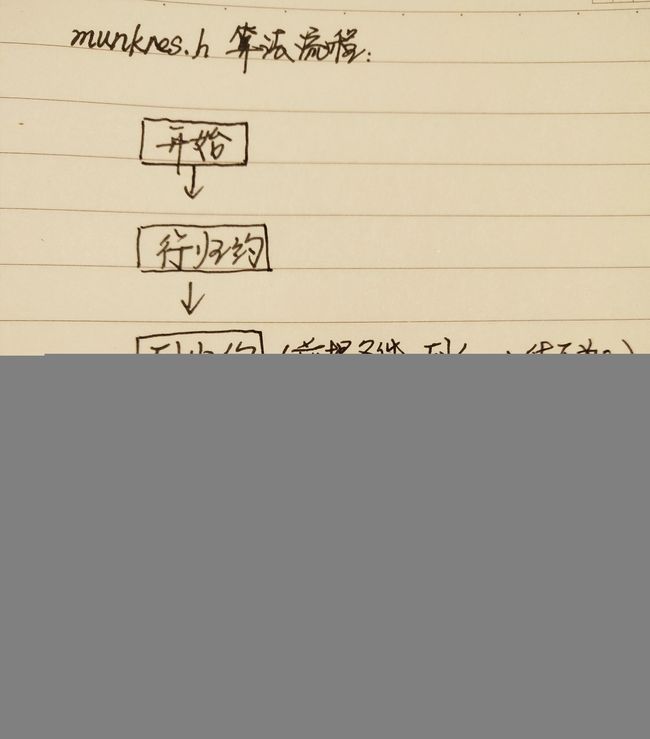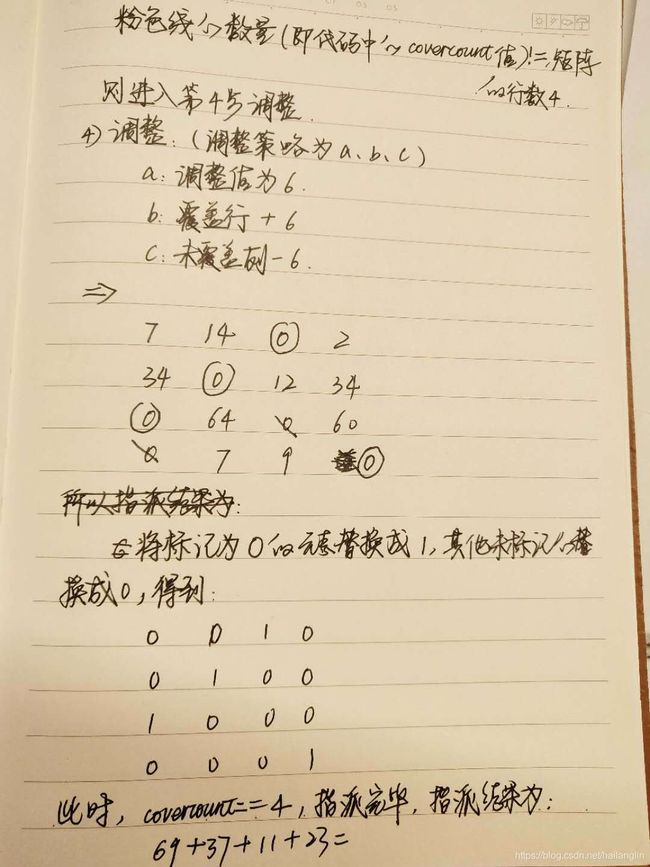多目标跟踪-DeepSort分析(二)HungarianOper模块代码分析
HungarianOper
https://blog.csdn.net/qq_25945437/article/details/70835157
https://blog.csdn.net/Kerrwy/article/details/81018202
在得到了上一帧的多个Bbox与这一帧的多个Bbox的IOU矩阵,需要找到最大IOU组合的索引对,論文使用匈牙利算法来進行匹配。在class HungarianOper—匈牙利指派模块中,核心功能
static Eigen::Matrix Solve(const DYNAMICM &cost_matrix)
是通過调用class Munkres 这个类來實現的(Ubuntu下輸入法有問題了,有时候是繁體字。。。)。Munkres算法是帶權重的一種指派算法。
Munkres算法流程如下:

前提:要求传进来的矩阵m是方阵,即行和列相等。if 行数!=列数,就resize 。
void solve(Matrix &m)
this->matrix = m;
if (rows != columns)
{
matrix.resize(size, size, matrix.mmax());
}
而且,如果存在无穷大的值,替换成矩阵的最大值。
replace_infinites(matrix);
以上是准备工作,下面進入munkres指派流程(请结合流程图和我的笔记看,同样没有学会在csdn画矩阵划线,所以就直接贴图了):


首先,對行進行規約,具體做法爲,在每行中找出最小值,然後每行都減掉這個最小值。
第二,進行列規約,前提是經過行規約後,該列的最小值不等於0,具體做法同行規約。
尋找最小值及規約代碼如下:
for (size_t j = 1; j < inner_size && min > 0; j++)
{
min = XYZMIN(min,over_columns ? matrix(j, i) : matrix(i, j));
}
if (min > 0)
{
for (size_t j = 0; j < inner_size; j++)
{
if (over_columns)
{
matrix(j, i) -= min;
}
else
{
matrix(i, j) -= min;
}
}
第三,進行試指派。
首先,画盖零线,通俗的理解为:用最少的横线来覆盖矩阵中所有被標記为0的元素.
在矩阵中,找到没有被盖零线覆盖的值.
inline bool find_uncovered_in_matrix();
if (find_uncovered_in_matrix(0, saverow, savecol))
{
mask_matrix(saverow, savecol) = PRIME; // prime it.
}
判定盖零线的数量covercount是否==矩陣的rows ||==矩陣的cols。如果等於,則指派成功.(这里,可以理解为:判定i行i列是否只有一个0元素,如果是,则说明指派成功.)
否則進行下一步:调整。
主0搜索
if (find_uncovered_in_matrix(0, saverow, savecol))
{
// 把它标记为prime
mask_matrix(saverow, savecol) = PRIME;
}
Increment Set of Starred Zeros
-
Construct the ``alternating sequence’’ of primed and starred zeros:
伪代码:Z0 : Unpaired Z' from Step 4.2 Z1 : The Z* in the column of Z0 Z[2N] : The Z' in the row of Z[2N-1], if such a zero exists Z[2N+1] : The Z* in the column of Z[2N] The sequence eventually terminates with an unpaired Z' = Z[2N] for some N. -
Unstar each starred zero of the sequence.
if (mask_matrix(i->first, i->second) == STAR) mask_matrix(i->first, i->second) = NORMAL;
3.Star each primed zero of the sequence
if (mask_matrix(i->first, i->second) == PRIME)
mask_matrix(i->first, i->second) = STAR;
- Erase all primes, uncover all columns and rows,
for (size_t row = 0; row < mask_matrix.rows(); row++)
{
for (size_t col = 0; col < mask_matrix.columns(); col++)
{
if (mask_matrix(row, col) == PRIME)
{
mask_matrix(row, col) = NORMAL;
}
}
}
最后返回结果,类型为matrix矩阵.